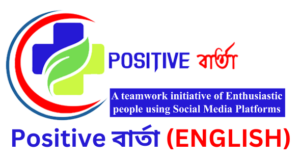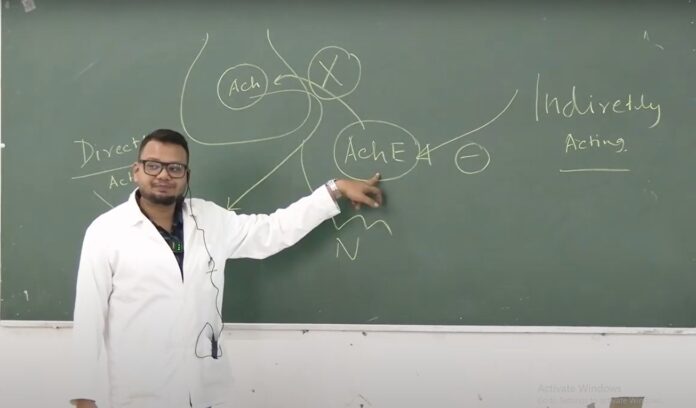Lecture on Cholinergic Medicine: Santiniketan Medical College & Hospital hosted an enlightening and comprehensive lecture on “Cholinergic Medicine: Pharmacology” by Dr. Analjyoti Ghosh, a renowned expert in the field of pharmacology. The event, aimed at medical students, was designed to provide them with a deeper understanding of the cholinergic system and its vital role in the human body. Dr. Ghosh’s lecture explored the intricacies of cholinergic pharmacology, discussing both theoretical concepts and practical applications in medical treatments.
Understanding the Cholinergic System
The cholinergic system, a critical component of the nervous system, operates primarily through the neurotransmitter acetylcholine (ACh). Dr. Ghosh began the lecture by explaining that acetylcholine plays a pivotal role in various physiological processes, including muscle movement, heart rate regulation, digestion, and respiratory function. He emphasized that disruptions in this system could lead to a range of health issues, such as Alzheimer’s disease, myasthenia gravis, Parkinson’s disease, and various types of neuropathies.
Dr. Ghosh elaborated, “The cholinergic system is one of the oldest and most well-understood systems in pharmacology. It controls several functions that are essential for the maintenance of normal bodily operations. Understanding how it works and how medications can influence it is crucial for treating various neurological and systemic conditions.”
The lecture also included an exploration of the two main types of cholinergic receptors in the human body: nicotinic and muscarinic receptors. These receptors are critical in the transmission of signals in both the central and peripheral nervous systems.
Cholinergic Drugs: Classification and Medical Applications
Dr. Ghosh outlined the classification of cholinergic drugs into two broad categories: cholinomimetic drugs and anticholinergic drugs. Each class has its specific use and effects, making it essential for clinicians to understand their indications and contraindications.
- Cholinomimetic Drugs: These drugs mimic the action of acetylcholine and are typically used to enhance cholinergic activity in conditions where the natural cholinergic system is impaired. Dr. Ghosh discussed several drugs in this category, such as acetylcholinesterase inhibitors, which prevent the breakdown of acetylcholine, thus increasing its availability. For instance, Donepezil is widely used in the management of Alzheimer’s disease, where it helps to slow down cognitive decline by increasing acetylcholine levels in the brain.
He also highlighted the use of drugs like neostigmine and pyridostigmine, which are used in treating myasthenia gravis, an autoimmune disorder that affects neuromuscular junctions and impairs muscle strength. Dr. Ghosh emphasized that these drugs help by improving the communication between nerves and muscles, thereby alleviating symptoms.
- Anticholinergic Drugs: These drugs block the effects of acetylcholine and are used in conditions where reducing cholinergic activity is beneficial. Dr. Ghosh noted that atropine and scopolamine are the most commonly used anticholinergic drugs. They are often used in treating motion sickness, reducing salivation during surgery, and in certain cases of bradycardia (abnormally slow heart rate), where they help to increase the heart rate by inhibiting the vagal response.
Anticholinergic drugs are also used in managing conditions like chronic obstructive pulmonary disease (COPD) and overactive bladder, as they reduce the excessive activity of the smooth muscles in the airways and bladder, respectively.
Mechanisms of Action: Nicotinic and Muscarinic Receptors
Dr. Ghosh went on to explain the mechanisms of action of cholinergic drugs in detail, focusing on the two types of receptors: nicotinic and muscarinic. These receptors are found in different tissues and organs, and they respond differently to cholinergic drugs.
- Nicotinic Receptors: These receptors are found at the neuromuscular junction, where nerves communicate with muscles. When acetylcholine binds to these receptors, it causes muscle contraction. Nicotinic receptors are also present in the central nervous system, where they play a role in cognitive function and memory.
Dr. Ghosh explained, “Nicotinic receptors are crucial in facilitating the transmission of signals from nerves to muscles, and drugs targeting these receptors can be used in various neuromuscular diseases to improve muscle strength and function.”
- Muscarinic Receptors: Muscarinic receptors are found in various tissues, including the heart, smooth muscles, and glands. These receptors play a role in regulating functions like heart rate, smooth muscle contraction, and secretion from glands. Muscarinic receptors are also involved in the parasympathetic nervous system, which controls ‘rest-and-digest’ functions.
Dr. Ghosh noted that drugs affecting these receptors can have significant therapeutic effects, particularly in managing conditions like glaucoma, where pilocarpine is used to reduce intraocular pressure, and in managing irritable bowel syndrome (IBS), where muscarinic antagonists can help reduce intestinal motility.
Side Effects and Risks of Cholinergic Drugs
While cholinergic drugs have significant therapeutic benefits, Dr. Ghosh also emphasized the potential side effects and risks associated with their use. Cholinomimetic drugs, especially those that increase acetylcholine levels, can cause adverse effects such as nausea, diarrhea, bradycardia, and muscle cramps. Overuse of these medications can lead to cholinergic toxicity, characterized by excessive sweating, salivation, and respiratory distress.
On the other hand, anticholinergic drugs, while effective in treating conditions like motion sickness and COPD, can lead to side effects such as dry mouth, blurred vision, constipation, urinary retention, and cognitive impairment, particularly in elderly patients. Dr. Ghosh cautioned that the elderly are particularly sensitive to the effects of anticholinergic medications and that careful monitoring is essential when prescribing these drugs.
Interactive Session with Students
The lecture included an interactive session where Dr. Ghosh encouraged students to ask questions and discuss real-life case scenarios. Students were particularly interested in how to balance the use of cholinergic and anticholinergic medications in various conditions. Dr. Ghosh provided insights into how understanding the patient’s medical history and the specific pathophysiology of their disease is crucial in determining the right treatment plan.
He concluded the session by emphasizing the importance of continuing education and staying updated with the latest research in pharmacology. “The field of pharmacology is constantly evolving, and it is essential for medical professionals to keep learning and adapting to new discoveries and treatment options.”
Conclusion: A Deepened Understanding of Cholinergic Medicine
The lecture on cholinergic medicine by Dr. Analjyoti Ghosh was an eye-opener for the students and faculty alike. By delving deep into the pharmacology of cholinergic drugs, Dr. Ghosh not only enhanced the students’ understanding of the subject but also provided them with practical knowledge that would be invaluable in their future medical careers. The students left the lecture hall with a renewed appreciation for the complexity of the cholinergic system and its central role in both health and disease.
The event at Santiniketan Medical College & Hospital was a significant step forward in integrating advanced pharmacological education into the curriculum, and it is expected that such sessions will continue to benefit the future generation of medical professionals.
Read More: Anatomy Discussions at Santiniketan Medical College & Hospital: Fostering a Culture of Inquiry







[…] Read More: Lecture on Cholinergic Medicine: Pharmacology by Dr. Analjyoti Ghosh at Santiniketan Medical College… […]